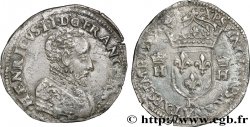v20_0265 - DANUBIAN CELTS - IMITATIONS OF THE TETRADRACHMS OF PHILIP II AND HIS SUCCESSORS Tétradrachme “au rameau”
MONNAIES 20 (2004)
Starting price : 250.00 €
Estimate : 380.00 €
Realised price : 375.00 €
Number of bids : 3
Maximum bid : 435.00 €
Starting price : 250.00 €
Estimate : 380.00 €
Realised price : 375.00 €
Number of bids : 3
Maximum bid : 435.00 €
Type : Tétradrachme “au rameau”
Date: (IIe-Ier siècles avant J.-C.)
Metal : silver
Diameter : 26 mm
Orientation dies : 7 h.
Weight : 13,64 g.
Rarity : R2
Coments on the condition:
Monnaie de bon style et portrait de haut relief bien centré avec une jolie patine de médaillier
Catalogue references :
Predigree :
Cette monnaie provient de la Vente UBS AG 59 (Union des Banques Suisses), n° 5053
Obverse
Obverse legend : ANÉPIGRAPHE.
Obverse description : Tête laurée de Zeus à droite. Grènetis.
Reverse
Reverse description : Cavalier au pas à droite, tenant une palme de la main droite ; le cheval lève l'antérieur à droite. Entre les jambes du cheval, I et E..
Reverse legend : FILIP - POU
Commentary
Si le statère d’or de Philippe II de Macédoine a servi de prototype à de nombreuses imitations gauloises, le tétradrachme n’a pas été imité en Gaule, mais reste principal sujet d’inspiration des monnaies pour les Celtes du Danube (LT. 9697-9767, 9768-9832, 9618-9630, 9870-9886). Les premières imitations furent frappées dans le premier quart du IIIe siècle avant J.-C. La fabrication des copies serviles, puis des imitations, enfin des frappes celtiques continuèrent pendant plus de deux siècles.








 Report a mistake
Report a mistake Print the page
Print the page Share my selection
Share my selection Ask a question
Ask a question Consign / sell
Consign / sell
 Full data
Full data















